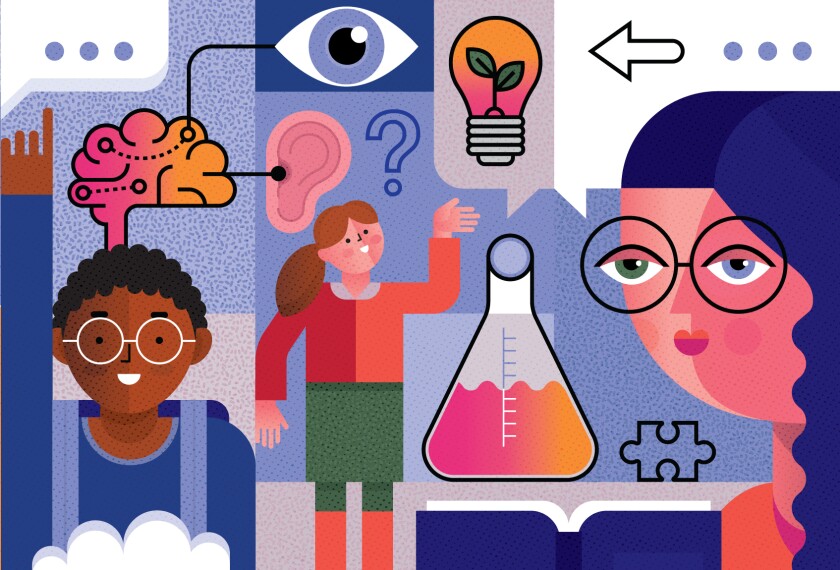Introducing students to STEM early, and consistently exposing them to those subject areas throughout their K-12 careers, can motivate students who might be searching for a subject that interests them to succeed academically, potentially changing the trajectory of their lives. And teachers can make that exposure happen in small ways throughout the school day, even when they don’t work in schools with robust STEM programs.
That was the message from educators who have managed to more closely incorporate science, technology, engineering, and math into their classrooms and schools during a recent webinar organized by the National Math and Science Initiative.
“STEM is everywhere,” said Kristen Vesely, the director of advanced academics in the Ector County, Texas, district. “There are so many everyday ways that we can introduce these concepts.”
The emphasis on STEM learning has continued to grow in recent years, as educators and employers increasingly work together to introduce students to STEM-related concepts and skills that can translate into in-demand jobs.
Some districts have poured big bucks into building STEM programs that carve out pathways for students to pursue training—and oftentimes receive postsecondary certificates—in a variety of related careers, from nursing to automotive technology to engineering. The goal is to provide a diverse assortment of opportunities for students to prepare for college or careers after high school in high-demand, high-paying jobs.
But that’s been far from a universal experience in K-12 schools.
Gaps persist in access to STEM programs based on whether districts have invested in them, and young people over time come to believe that boys are more inclined than girls to succeed in those subjects. Districts also face challenges filling STEM-specialty teaching positions.
Even without those major investments and formal advanced STEM programs, however, teachers of all grade levels and subject areas can still take steps to introduce STEM concepts in their classrooms, Vesely said.
Teachers can look to a new technology-related trending topic—like artificial intelligence—and create opportunities to discuss the new tool, how it works, and emphasize that people have careers developing and maintaining those tools. Such discussions help plant a seed, and get kids thinking about topics that interest them and how their interests can someday translate to jobs, Vesely said.
Teachers can also prioritize teaching analytical skills, creative thinking, and asking questions, she said—all crucial skills in STEM fields.
“You have more resources at your hands than you think,” Vesely said. “Most classes that I step into have STEM ideas in them, and teachers are making mindset shifts … and really starting to allow the students to own their learning.”
Teachers can also use field trips as an opportunity to introduce STEM concepts, said Robin Johnson Ford, the director of advanced academies in the DeSoto, Texas, school district. She recalled taking students to the post office, for example, and talking about the logistics of processing and delivering mail and the technology that helps make it happen.
“It doesn’t have to be enormous,” she said. “I think people think, ‘I have to have all this stuff [to teach STEM], but just one experience can literally open doors to creating a STEM culture and STEM mindset. You just have to figure out, what’s that one thing that’s … within my reach?”
Teachers can also be strong advocates for incorporating STEM, said Todd Allen, the principal of Lady Bird Johnson Middle School in Irving, Texas.
Educators can have influential conversations with school administrators and district leaders, making the case for integrating STEM teaching and other related opportunities more often through the school day. It can be helpful to recruit other teachers to share stories, anecdotes, and information about potential programs and opportunities, he said.
Efforts big and small to introduce STEM to students can influence their entire educational journey, and, for some, even the trajectory of their lives, the panelists said.

One student in Vesely’s Texas school many years ago had a difficult time for much of his academic career. Educators’ main goals for him were merely to keep him passing his classes and on pace to graduate, she said. Then, in high school, he took some career and technical education courses related to mechanical engineering, and “it sparked something in him,” Vesely said.
When he graduated from high school, he wasn’t at the top of his class, or even in the top 10, she said. But he had a passion. Now, he is a successful adult who owns a business and works in mechanical engineering, she said.
In Irving, Allen has a student this year who began working on a class project about noise pollution and has found a passion for the subject. The student has worked with local experts as part of the project to learn more and participate in hands-on learning opportunities, Allen said.
“I think this research opportunity that presented itself in his 7th grade class may, in turn, take this student on a pathway that six months ago he would have never had,” he said. “This is going to be a young man who, in this one interaction, changed his entire perception and could lead him to a STEM career.”
Plentiful STEM exposure can also be helpful for students who ultimately don’t choose a career in one of those fields, Vesely said. Her district has a large population of students in bilingual education programs, she said, and when students who struggle in other classes can participate in the more hands-on, inquiry-driven STEM classes, “you watch them light up,” she said.
“It gives them that opportunity to engage differently with the material—they’re doing something with their hands,” she said. “And that, in turn, builds their belief in themselves in other classes. So they walk out of there and they go into English and, suddenly, they believe that they can do it, and we see an increase in academics across the board.”






